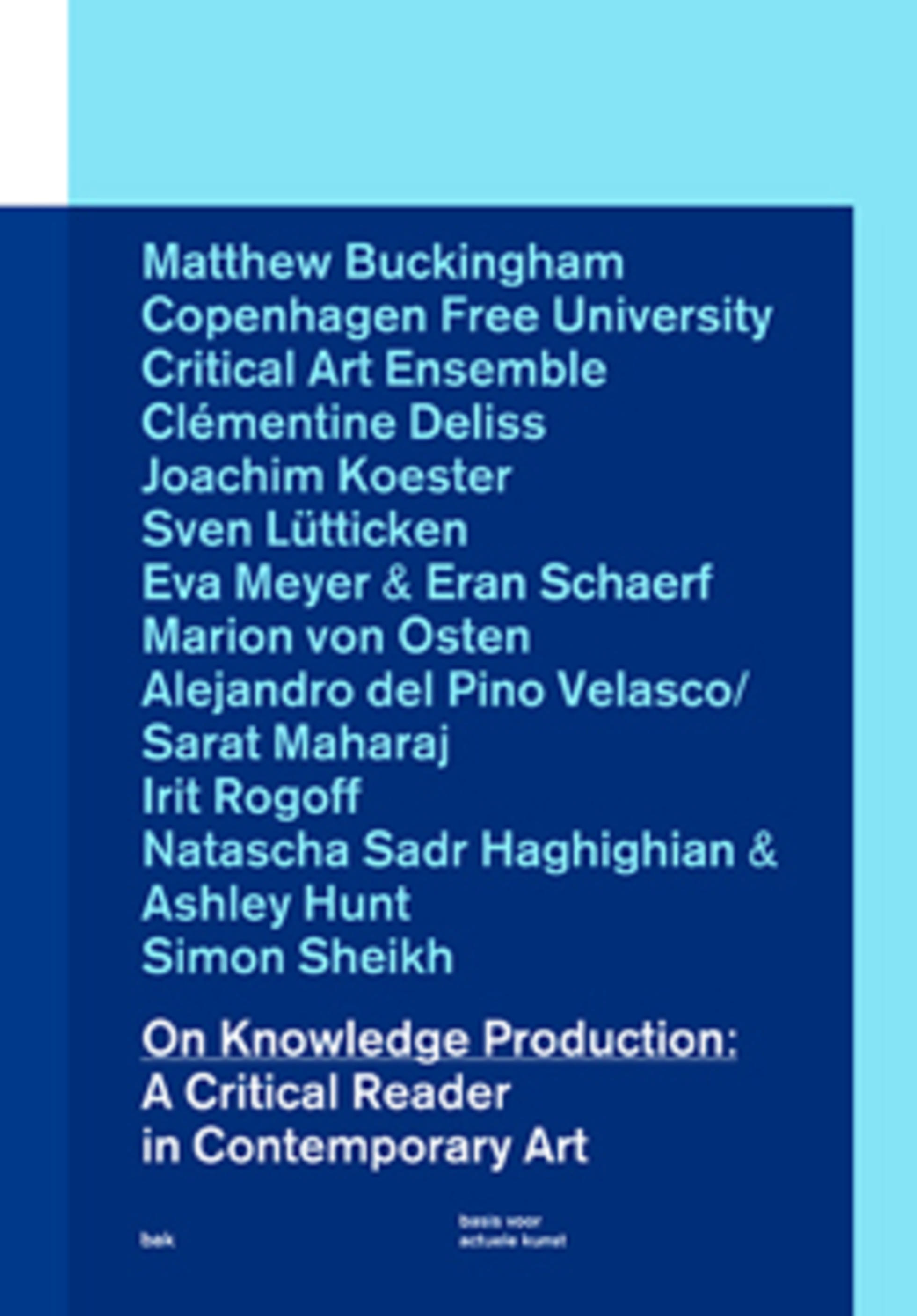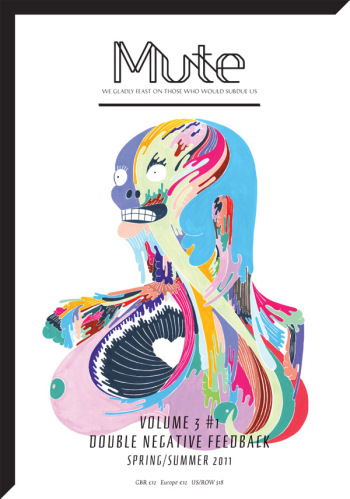Hlavajova, Winder, Choi (eds.): On Knowledge Production: A Critical Reader in Contemporary Art (2008)
Filed under book | Tags: · art, contemporary art, education, knowledge economy, knowledge production, neoliberalism

“On Knowledge Production presents a selection of newly commissioned and anthologized texts by a diverse group of artists, art historians, philosophers, and theorists who have engaged with thinking critically about the field of art as a site for the production of knowledge. The body of contributions to this reader comprise a series of critical inquires, thought experiments, documents of practice, and tentative propositions about the status of producing knowledge in contemporary art, which vary widely in perspective, approach, and form. This selection unfolds different entry points and layers, unwrapping the (often) uncritically adopted notion of “art producing knowledge” and casting diverse views on the context, meaning, and potential of this understanding of art practices today.”
With contributions by Matthew Buckingham, Copenhagen Free University, Critical Art Ensemble, Clémentine Deliss, Joachim Koester, Sven Lütticken, Eva Meyer & Eran Schaerf, Marion von Osten, Alejandro del Pino Velasco/Sarat Maharaj, Irit Rogoff, Natascha Sadr Haghighian & Ashley Hunt, and Simon Sheikh.
Edited by Maria Hlavajova, Jill Winder, and Binna Choi
Publisher BAK-basis voor actuele kunst, Utrecht, and Revolver, Archiv für aktuelle Kunst, Frankfurt am Main
ISBN 9789077288115 (BAK), 9783865884664 (Revolver)
223 pages
Out of print
PDF (no OCR, updated on 2017-4-2)
Comments (2)Mute, 3(1): Double Negative Feedback (2011)
Filed under magazine | Tags: · architecture, art, capitalism, contemporary art, cultural politics, economics, financial crisis, journalism, music, neoliberalism, networks, politics, uk, wikileaks

“‘Double Negative Feedback’ expresses the hope that the chaos unleashed by the cybernetic loops of financialisation, post-Fordist production and networked life might not only be entropic and exploitative. The noise generated by ‘positive feedback’ also takes the form of the explosions we are seeing in the Arab world, the anti-disciplinary uses of cybernetic control systems, the ‘shared precarity’ of compositional improvising, and the ripples of a political organising that no longer assumes a common identity but instead acknowledges our common vulnerability. This issue scouts out such double-negative loops in a landscape dominated by the relentless, if often misfiring attempt to put feedback to work.”
Edited by Josephine Berry Slater
Publisher Mute, London, June 2011
NJP Reader #1: Contributions to an Artistic Anthropology (2010) [English, Korean]
Filed under book | Tags: · aesthetics, anthropology, art, contemporary art

“The Nam June Paik Center is dedicated to the artistic and intellectual legacy of Nam June Paik, the renowned Korean-born artist who transformed visual art worldwide. In addition to its function as an exhibition space, the Nam June Paik Art Center developed a new publication, NJP Reader. The aim of the NJP Reader is to recontextualize Nam June Paik’s artistic thought and his ‘random access’ strategies in a topical discursive practice. Leading questions are: What is the meaning of Nam June Paik’s multi-medial experiments, performances, and sculpture for our current artistic practice and discourse? What new dimensions for re-imagining notions of technology, ubiquity, and human experience do Nam June Paik’s thinking and practice suggest? How does his practice potentiate paradigm shifts in broader understandings of the potentialities and characteristics of alternative processes of participation afforded by the introduction of media technology into artistic practice?
Obviously, Nam June Paik’s work requires a conceptual framework that goes beyond an art historical narrative. Therefore, for Issue #1, NJP Reader conducts an inquiry into the novel concept of artistic anthropology in art discourse as an invitation to produce new conceptual systems. The NJP Reader intends to be an open platform for generating novel ideas, connections and concepts (this intention is also reflected in choosing to use Nam June Paik’s initials for its title, rather than his full name). To this aim, the first edition of the NJP Reader is based on a questionnaire that as many artists and intellectuals as possible were invited to contribute responses to. Through this conceptual inquiry the NJP Reader hopes to help in creating novel lines of thought and conceptual schemes. For the questionnaire three questions were formulated:
1. Artistic anthropology intends to produce novel models of relationality and connectivity. Could – Nam June Paik’s legacy as a form of – artistic anthropology contribute to an artistic discourse going beyond the framework of relational aesthetics? Who are the artists in our day developing relevant examples of rethinking and recontextualizing an artistic anthropology?
2. What could artistic anthropology mean for a current artistic practice? How could it relate to medium-specific qualities? Is it a form of artistic communication defined by a post-medium condition? Or is it a practice that demands the concept of medium-specificity to change?
3. What could artistic anthropology – as a form of knowledge production – mean for the current classification system? Will it challenge the dominant paradigms of the established humanities and sciences? What type of new models might this trigger? How can artistic anthropology contribute to a better and more political understanding of the human condition? And what could artistic anthropology mean for the concept of art in general?”
Contributors: Ricardo Basbaum, Jean-Paul Fargier, Ranjit Hoskote and Nancy Adajania, Jeongwhan Jo, Clara Kim, Lev Manovich, Arjen Mulder, Simon O’Sullivan, Wongil Park, John Rajchman, Susanne Rennert, Szabolcs KissPál, Peter Weibel, Haegue Yang, Hiroshi Yoshioka, David Zerbib.
Editors: Youngchul Lee, Henk Slager
Final Editor: Annette W. Balkema
Publisher: Nam June Paik Art Center, Korea, 2010
ISSN 2092-9315
68 pages
PDF (English, updated on 2012-11-19)
PDF (Korean, updated on 2012-11-19)

